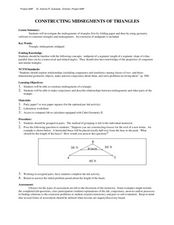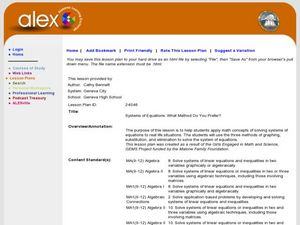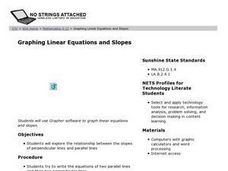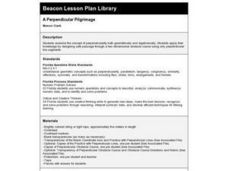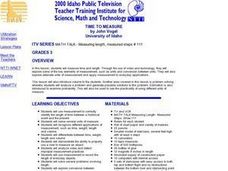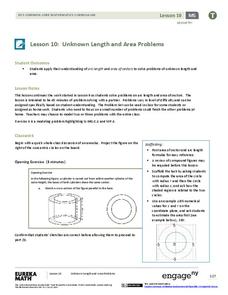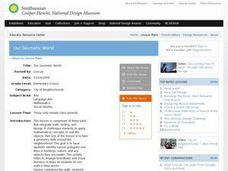Curated OER
Constructing Midsegments of Triangles
Learners construct midsegments. In this geometry lesson plan, students make conjectures and apply properties of triangles to solve problems. They complete an activity on the computer.
Curated OER
Systems of Equations: What Method Do You Prefer?
Students explore the concept of solving systems of equations. In this solving systems of equations lesson, students watch YouTube videos about how to solve systems by graphing and by elimination. Students use an interactive website to...
NY Learns
Investigation - Looking at Polygons
Middle schoolers construct polygons by plotting points on a coordinate plane. Pupils connect the points and identify which polygons they have drawn. They will need graph paper to carry out the assigned activities. A vocabulary list,...
Curated OER
Bulbs & Batteries Side by Side
Learners build parallel circuits, exploring how they function and looking at their unique features. They describe how current changes when batteries are added in parallel or removed from a parallel arrangement, demonstrate the process of...
Curated OER
Graphing Linear Equations and Slopes
Students explore linear equations, parallel lines, perpendicular lines and slopes. Using computers with graphic calculators and word processing, students examine the relationship between the slopes of perpendicular lines and parallel...
Curated OER
Reflections over Two Lines & Dilations
Learners create reflections over two lines. In this reflections worksheet, students compare and contrast reflections over parallel and intersecting lines. They dilate figures and investigate the effect of the dilation using measurement...
Curated OER
Solving Problems Involving Chords, Radii, Tangents, Secants and Arcs within the Same Circle
Tenth graders apply their knowledge of angles related to a circle, radii, secants, tangents and chords of a circle. They practice using formulas related to a circle. They also apply what has been practiced to real life situations.
Curated OER
Getting Percentible
This unit explores the connections between percentages, decimals, and fractions. It focuses on strategies for solving problems involving percentages and applies these strategies to real life contexts.
Curated OER
A Perpendicular Pilgrimage
Ninth graders design a safe passage through a 2-D obstacle. In this geometric math lesson, 9th graders engage in a hands on activity to better understand the concept of geometric and algebraic perpendicularity. Students will work in...
Curated OER
Light Bounce
Students solve problems involving triangles. In this geometry instructional activity, students apply properties of triangles to find the missing angles and sides. They identify angles of parallel lines cut by a transversal.
Curated OER
Time To Measure
Third graders measure time and length. Through the use of video and technology, they explore key elements of measurement, such as units and conversion between units. They explore alternate units of measurement and apply measurement to...
Curated OER
Investigating Scale Factors with the Geometer's Sketchpad
Pupils use Geometer's Sketchpad to examine the scale factor when in is applied to the length of a figure's sides. They look at how the scale factor affects the side lengths, perimeter, and area of the figure that result. They work with...
Curated OER
As the Bird Flies
Students investigate the properties of lines and congruent triangle theorems as well as apply geometric properties and relationships to real-world mathematical problems. Given two different scenarios, they examine maps that have been...
Curated OER
Distance in Coordinate Geometry
Students analyze distance and graphing. In this geometry lesson, students work problems on a coordinate grid calculating the distance. They apply the Pythagorean Theorem to their data and answer.
Curated OER
Angles, Parallel Lines, and Polygons
Learners examine how to investigate polygons using an instrument of their own construction. They should be able to prove the general formula for the number of degrees in any polygon (including a triangle). Finally they investigate an...
Illustrative Mathematics
Equal Area Triangles on the Same Base II
A deceptively simple question setup leads to a number of attack methods and a surprisingly sophisticated solution set in this open-ended problem. Young geometers of different strengths can go about defining the solutions graphically,...
EngageNY
Unknown Length and Area Problems
What is an annulus? Pupils first learn about how to create an annulus, then consider how to find the area of such shapes. They then complete a problem set on arc length and areas of sectors.
EngageNY
Counting Rules—The Fundamental Counting Principle and Permutations
Count the benefits of using the resource. The second installment of a 21-part module focuses on the fundamental counting principle to determine the number of outcomes in a sample space. It formalizes concepts of permutations and...
Curated OER
"Adding It Up" at James Fort
Students discuss jettons and their archaeological importance at Jamestown. They then practice using historic counting sheets and artifacts to understand the calculating methods of the early 17th Century, and identify their similarities...
Curated OER
Our Geometic World
Pupils walk around the neighborhood and identify various polygons and lines in buildings, nature and other objects. They design a building using various geometric patterns, shapes and lines. Students complete a descriptive writing of...
Curated OER
Geometry: Lesson 8
Eighth graders engage in a lesson that is concerned with the finding of angles that are found in different two dimensional figures. They compare and contrast exterior and interior angles while also determining the unknown measures of...
Curated OER
Learning by Logic - Total Surface Area
Geometers calculate the area of plane surfaces using the formulas for the area of a square, rectangle, and triangle. They develop the formula for calculating the total surface area of two geometric solids: the cube and rectangular prism.
Curated OER
Prairie Adaptations
Twelfth graders consider the survival of prairie plants. They examine how some tallgrass prairie species are adapted to the conditions of their ecosystem. They make a prediction of how a species might change given new conditions.
Improving Measurement and Geometry in Elementary Schools
The Sum of the Interior Angles of a Polygon
Junior geometers discover that polygons can be decomposed into triangles and that the number of triangles can be determined by a rule. Note that the Geometer’s Sketchpad® software is required to carry out all components of this...


